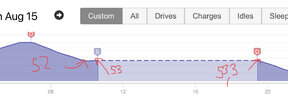My 2019 Dual Motor M3 never had the 310 range I was promised. I started at about 305. It dropped to about 284 (derived from the Stats app) by 60k miles. This seems like a standard drop, from what I have read. But just in the last two months, it went from 283-286 or so, down to 274 almost overnight. Do any of you battery experts think this was actual degradation or reflective of the tremendous heat we have had this summer, and a sudden change in driving habbits? I'm in Boston and since July 1, most of my driving since this started was 120 mile trips out to Cape Cod (and back), which I do a couple times per week. When I'm not driving, the car is unavoidably baking in the very hot sun.
In the end, it is what it is, and I don't get too worked up over the range, but this has kind of been bugging me seeing it drop so quickly from ~284 to ~274.
Other info: I rarely supercharge (maybe 12 times since buying the car.) I use winter tires when the temps drop below 45, which were swapped out in April for a new set of MXM4s. I don't drive especially aggressively (but, hey, sometimes we all step on the go pedal!) I used to charge immediately arriving at home to 80% until about 40,000 miles, when I read the long battery thread and started to realize that less is better. Since 40k miles, I now charge beginning at 5am. I charge to 70% when I have a typical work day, 80-88% infrequently when taking longer work drives. I rarely charge over 90%, but maybe a dozen times to 98% for road trips. Might have charged to 100% a couple of times. Never been below 6%. Typically I try to keep it around 58% when the car is going to be sitting around for a few days (with local errands, etc.)
Thanks for any input!
In the end, it is what it is, and I don't get too worked up over the range, but this has kind of been bugging me seeing it drop so quickly from ~284 to ~274.
Other info: I rarely supercharge (maybe 12 times since buying the car.) I use winter tires when the temps drop below 45, which were swapped out in April for a new set of MXM4s. I don't drive especially aggressively (but, hey, sometimes we all step on the go pedal!) I used to charge immediately arriving at home to 80% until about 40,000 miles, when I read the long battery thread and started to realize that less is better. Since 40k miles, I now charge beginning at 5am. I charge to 70% when I have a typical work day, 80-88% infrequently when taking longer work drives. I rarely charge over 90%, but maybe a dozen times to 98% for road trips. Might have charged to 100% a couple of times. Never been below 6%. Typically I try to keep it around 58% when the car is going to be sitting around for a few days (with local errands, etc.)
Thanks for any input!



